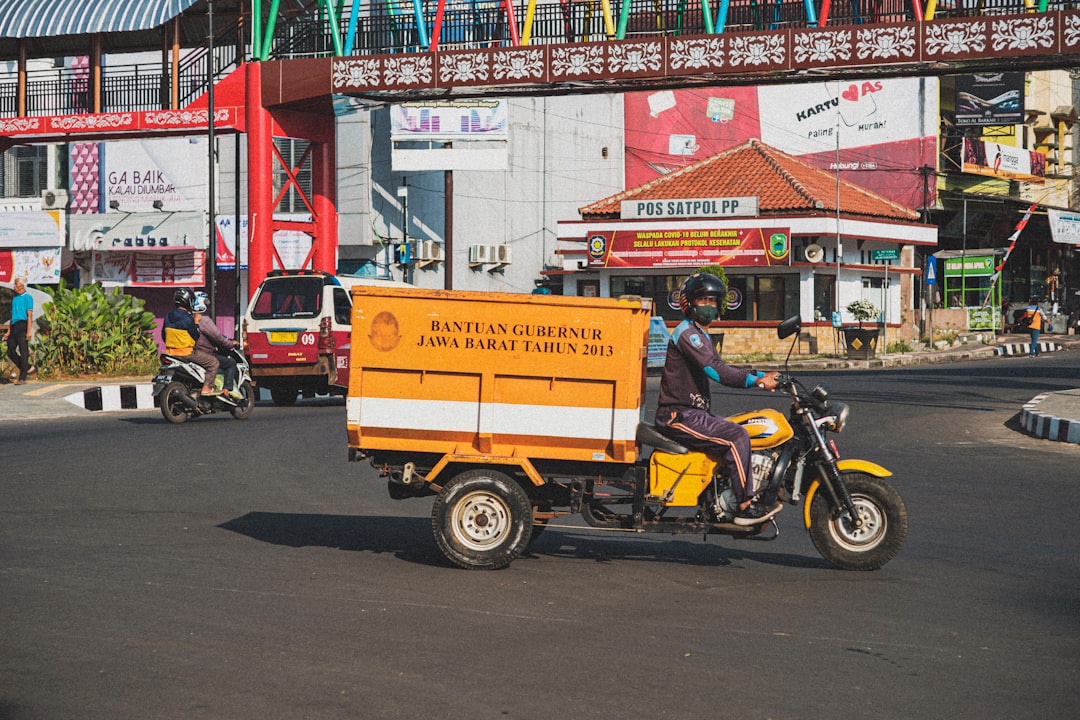

Engage prospects with a scan and streamline customer engagement with FREE QR code marketing tools by Sona – no strings attached!
Create a Free QR CodeFree consultation

No commitment

Engage prospects with a scan and streamline customer engagement with FREE QR code marketing tools by Sona – no strings attached!
Create a Free QR CodeFree consultation

No commitment
In today’s digitally driven world, QR codes have transformed from a novelty into a strategic powerhouse for bridging offline engagement with online action. For scooter repair services, QR codes offer a frictionless and highly effective way to boost customer engagement, enable fast access to essential service information, and streamline the repair experience, all without the need for app downloads or complex setup.
Many shops still struggle with common pain points: missed high-value prospects who never fill out a contact form, fragmented experiences across channels, and limited insight into which offline touchpoints drive revenue. As a result, valuable leads often do not make it into the CRM, and analog processes leave shop owners blind to customer intent.
This transition opens a new world for scooter shops and maintenance providers. QR codes facilitate instant connections between printed materials, signage, and digital resources, helping customers book services, access repair tips, or check maintenance schedules with a simple scan. New shops can reference this startup guide.

Scooter repair businesses often face friction when moving customers from physical touchpoints to digital engagement. Analog brochures or paper forms result in slow service, lost opportunities, and manual errors. They also leave owners unaware of customer interest in their services because interactions are not tracked. QR codes bridge this divide by making every surface scannable: a receipt, a tag on the scooter, a window sign, or a flyer.
Industry leaders now overcome these challenges by using QR codes to support business goals like increased appointment bookings, reduced inbound phone calls about repair status, faster check-ins, and improved customer satisfaction. The most effective teams treat QR deployment as a core part of their operations, not just a marketing add-on. With dynamic QR platforms such as Sona QR, shops can update destinations in real time, route scanners based on context, and feed scan activity directly into CRMs for attribution and follow-up.
Modern QR platforms make deployment, updates, and attribution simple. Shops gain visibility into the leads that would otherwise slip through the cracks and can act quickly with targeted messaging, timely reminders, and tailored offers tied to the repair journey.

Scooter repair providers operate in a high-paced environment where riders want quick answers and easy access to solutions. Offline touchpoints like window signs, counter displays, invoices, and printed manuals dominate the customer journey, yet they rarely convert without a bridge to digital action. QR codes deliver that bridge and turn every physical moment into a low-friction path to a result. See current e-scooter trends for context.
QR codes solve these recurring challenges and align with scooter service workflows:
In practical terms, QR codes let scooter repair teams compress the distance from curiosity to conversion. A passerby can become a booked appointment in 60 seconds. A customer waiting for parts can check status in real time. A new rider can enroll in a tune-up plan by scanning a label on their scooter. The small act of scanning removes friction that otherwise turns into lost revenue or avoidable calls.
Not all QR codes serve the same purpose. Scooter repair workflows benefit from formats that reduce friction during intake, service, and follow-up. Focus on formats that match the intent of each touchpoint and keep destinations concise.
Dynamic QR codes are particularly valuable for scooter service because content changes often. With Sona QR, you can update destinations, route by language or location, and capture granular analytics. Static codes are fine for permanent destinations like your main booking link, but dynamic codes deliver flexibility and data for campaigns, promotions, and evolving service pages.

Scooter repair services interact with customers across dozens of analog moments: a rider peering through the window after hours, a commuter with a squeaky brake considering a quick tune-up, or a delivery driver who wants faster turnaround times. Each moment can convert if you place a scannable path to action.
Targeted placements matched to lifecycle stages turn each interaction into a new lead or upsell opportunity. Using Sona QR, you can tag scans by context such as window sign after 6 p.m., invoice post-service, or tutorial view from manual. This segmentation helps teams personalize follow-up and allocate budget to placements that drive the most conversions.

Leading repair shops improve customer experience and business outcomes by placing QR codes at pain points that typically cause drop-off or extra work for staff. Three high-impact use cases consistently deliver results.
Each of these use cases can be configured with a dynamic QR destination so you can refresh content, alter promotions, or redirect based on seasonality. For example, promote winter tune-ups or summer battery checks with the same printed materials by updating the link in Sona QR.
Every QR scan is a signal that reveals intent, context, and proximity to purchase. By deploying unique codes at different points in the journey, scooter repair shops can segment audiences automatically and feed that data into remarketing workflows.
Start by mapping the lifecycle and matching QR placements to funnel stages. Then tag scans to build segments that your CRM and ad platforms can use for relevant follow-up. The key is to segment by behavior rather than guesswork, using the physical context of the scan as a proxy for interest.
For scooter repair specifically, segmenting by rider profile is powerful. Separate commuters who need fast turnarounds, delivery riders or gig workers who value extended hours, new owners who need education and maintenance plans, and enthusiasts interested in performance upgrades. Tailor offers accordingly, then use Sona QR analytics to track which segments convert and fine tune your campaigns over time.
QR codes do more than connect print to web. They unify your offline and digital marketing into a coherent system that tracks, learns, and improves. With each scan, you gain visibility into which posters, cards, or receipts are driving action, and you can automate follow-up that aligns with the customer’s stage.
Here are five practical ways to integrate QR codes across the scooter repair marketing mix:
QR codes become the offline onramp to your digital marketing engine. With a centralized platform like Sona QR, you can manage all your codes, monitor performance, and sync scan data with your CRM and ad platforms. This connected approach turns scattered materials into a measurable funnel that progresses riders from awareness to repeat service.
Operational headaches such as outdated asset versions, inconsistent calls to action, and lack of attribution can undercut campaign ROI for scooter repair services. This structured checklist avoids those pitfalls by aligning each step with a clear outcome and a measurable signal. Use this process to plan, launch, and improve every QR initiative.
Before diving into the steps, define one business problem to solve. Examples include long wait times at intake, a high volume of status calls, low review volume, or poor conversion from foot traffic. With that focus, you can select the right QR format, destination, and placement to change behavior.
Start with the outcome, then pick the use case that achieves it. If you need more bookings, focus on prominent placements and a one-step form. If you need fewer phone calls, prioritize a status portal linked from receipts and repair tags.
Select the format that best matches the action you want. Dynamic codes are recommended for most campaigns so you can edit destinations, tag sources, and run A/B tests without reprinting.
Good design and clear messaging can double scan rates. Build visual cues around the code so people understand the benefit, and test in the environment where the code will live.
Roll out your codes where they will make the biggest difference. It is better to pilot a few high-traffic placements with great messaging than to scatter codes everywhere without intent.
Treat QR deployment as a living system. Watch the data, learn, and iterate. Use Sona QR to keep this process fast and consistent across campaigns.

Scooter repair businesses sometimes mistake scan volume for success. A high number of scans is a positive signal, but without linking scans to real outcomes like booked appointments, paid invoices, and repeat visits, you cannot optimize effectively. The goal is to tie each physical-to-digital interaction to a measurable revenue event.
Modern tracking solutions such as Sona QR capture each key attribute of a scan like location, timing, and device, then send that data to your CRM for attribution. This creates a clear line of sight from a window poster to a new customer record, from a receipt link to a completed review, or from a flyer to a booked tune-up. Over time, you can see which placements, messages, and offers drive the most value.
Sona QR captures real-world engagement with detailed scan analytics. Sona turns that engagement into actionable insights, linking QR interactions with website visits, ad clicks, email opens, and CRM activity. With identity resolution and multi-touch attribution, you can connect anonymous scans to known buyers, quantify the impact of QR on pipeline and revenue, and scale what works.
Fragmented or generic QR deployments waste spend and yield little insight. The most effective shops build a consistent QR strategy that matches their physical media, supports a clear journey, and integrates with their tech stack. Use these tips to accelerate returns and avoid common pitfalls.
A flexible, data-driven approach lets scooter repair services capture hidden demand, reduce friction, and drive measurable growth. The more intentional your placements and follow-up, the more value you will capture from every scan.
QR codes have become essential for scooter repair shops that want to close the gap between offline interactions and digital conversions. By embedding codes throughout the customer journey and integrating scan data with smart segmentation and follow-up, repair providers can solve persistent frustrations such as lost leads, fragmented campaigns, and untracked engagement. The result is a connected experience where riders always have a next step, and shops gain clear visibility into what drives bookings and loyalty.
Focusing on seamless access, actionable analytics, and relevance to the rider’s context is the key. With dynamic QR codes managed through Sona QR, you can update destinations without reprinting, route scans by placement, and sync engagement to your CRM. With Sona.com, you can attribute scans to pipeline and revenue, unify touchpoints across the journey, and optimize your marketing mix based on real outcomes.
For scooter repair teams ready to modernize, the path is straightforward. Identify the offline moments that matter, place a clear scannable action within reach, and connect the data so you can learn and improve. Begin with one or two high-impact use cases such as booking and repair status, then expand to reviews, tutorials, and loyalty over time. Start creating QR codes for free and be live in minutes.
The shops that embrace QR technology now will set a new standard for speed, convenience, and transparency. Every receipt, sign, and scooter can become an entry point to a better customer experience and a stronger business.
QR codes have revolutionized scooter repair services by transforming how customers access vital information and service options instantly. Whether it’s streamlining appointment bookings, providing real-time repair status updates, or offering maintenance tips, QR codes enable seamless, mobile-friendly interactions that enhance customer satisfaction and operational efficiency. Imagine your customers scanning a code to schedule repairs or check service history without delay—boosting loyalty and repeat business.
With Sona QR, you can effortlessly create dynamic, trackable QR codes that update instantly without the need for reprinting, ensuring your service information is always current. Every scan becomes a valuable data point, helping you understand customer behavior and optimize your marketing efforts to attract new clients and retain existing ones. Start for free with Sona QR today and turn every scan into a smooth repair experience and a stronger connection with your customers.
You can find reliable scooter repair services by looking for shops that use digital tools like QR codes to streamline bookings and provide clear repair status updates, ensuring faster and more transparent service.
Common scooter repair issues include brake problems, battery replacements, tune-ups, and maintenance tasks that can be addressed through professional service or guided DIY tutorials accessed via QR codes.
Repair costs vary depending on the issue, but shops using QR codes often provide instant quotes and dynamic pricing updates accessible by scanning codes on signage or receipts.
Best practices include identifying outdated analog processes to digitize, deploying QR codes for seamless customer engagement, defining clear success metrics, using essential tools, and integrating marketing strategies to track and optimize performance.
QR codes enhance customer experience by enabling quick access to booking forms, repair status tracking, troubleshooting videos, contact saving, and promotions without app downloads or long forms.
While the article focuses on digital tools, essential physical tools include repair kits for brakes, batteries, and tires, and digitally, platforms like Sona QR for managing QR code campaigns and customer interactions.
Ensuring high-quality service involves using QR codes to reduce manual errors, improve appointment bookings, provide transparent repair status updates, and collect customer feedback efficiently.
Promote your service by placing QR codes on receipts, storefront signage, flyers, scooter labels, and loyalty cards with clear calls to action that link to booking forms, repair status pages, or contact info.
Effective strategies include integrating QR codes across print collateral, social media, direct mail, digital signage, and events to track engagement, build segmented audiences, and automate personalized follow-ups.
Track performance by using dynamic QR codes with analytics to monitor scan rates, conversion metrics, and customer feedback, integrating data into CRM systems like HubSpot or Salesforce for attribution and optimization.
Use Sona QR's trackable codes to improve customer acquisition and engagement today.
Create Your FREE Trackable QR Code in SecondsJoin results-focused teams combining Sona Platform automation with advanced Google Ads strategies to scale lead generation

Connect your existing CRM

Free Account Enrichment

No setup fees
No commitment required

Free consultation

Get a custom Google Ads roadmap for your business






Launch campaigns that generate qualified leads in 30 days or less.
